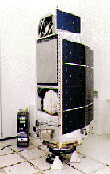|
The HEAO-3 Satellite The HEAO-3 satellite carried three high-energy-astrophysics instruments, one instrument surveying the sky in hard X-rays and gamma rays, and two measuring the composition of cosmic rays. The High Resolution Gamma-Ray Spectrometer Experiment built by the Jet Propulsion Laboratory was the largest germanium spectrometer placed in orbit at that time. The cosmic-ray instruments, one built by a Danish-French collaboration and the other built as a collaboration among Washington University in St. Louis, Caltech, and University of Minnesota were the largest cosmic-ray detectors to have flown in space. Mission Characteristics
Page authors: Lorella Angelini Jesse Allen HEASARC Home | Observatories | Archive | Calibration | Software | Tools | Students/Teachers/Public Last modified: Thursday, 24-Sep-2020 19:43:17 EDT |

